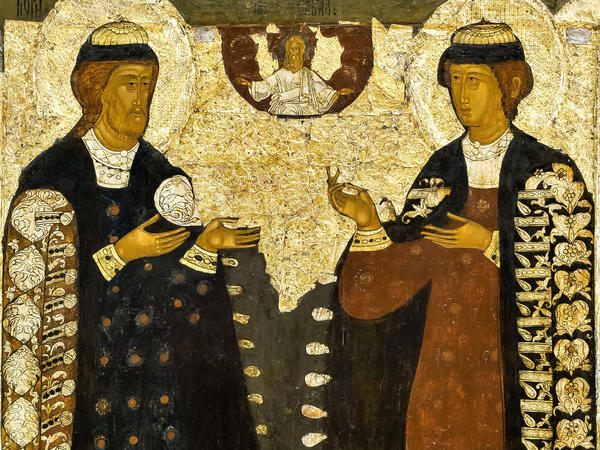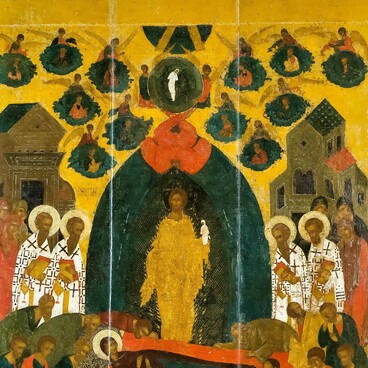The icon ‘Saint Princes Boris and Gleb’ was painted in the 1580s. The icon depicts the younger sons of the Grand Prince Vladimir who Christianized the Kievan Rus. Legend has it that after the death of Prince Vladimir in 1015, his eldest son Svyatopolk killed his own brothers to get rid of potential claimants to the throne of Kiev.
According to the Lives of Boris and Gleb, the princes were devout Christians and accepted their death as martyrs in the spirit of resignation. After that, the elder brother was nicknamed Svyatopolk the Accursed, while princes Boris and Gleb were canonized and became the first Russian saints. Soon, a church was built in Vyshhorod in honor of the saint princes.
After their canonization, special traditions were established for the iconography of the saints. The brothers were revered as the patron saints of princes and the protectors of their armed forces. The saints are traditionally depicted facing the viewer, holding a cross in the right hand and a sword pointing to the ground in the left hand.
‘Saint Princes Boris and Gleb’ from the museum’s collection is an example of unusual iconography. The princes appear praying to the Lord of Hosts who is depicted in the upper part of the icon. The saints face the center of the composition. Princes Boris and Gleb are shown without the typical attributes in their hands — the cross and sheathed swords which symbolize martyrdom and military valor.
The icon painter thoroughly detailed the expensive decorations on the princes’ clothes. The ornaments on the fabric and the fasteners on the fur cloaks imitate embroidery, as well as silver and gold decorations.
The icons presented in the museum collection — ‘Saint Princes Boris and Gleb, ” “John the Apostle in Silence, ” and “The Queen Did Stand” — form an artistic unity. They were created at the same icon workshop.
The icon was placed in the bottom tier of the iconostasis of the Trinity Church in Sviyazhsk. It was first mentioned in the inventory of the Trinity Monastery of St. Sergius in 1641. However, the image might have been initially placed in the iconostasis of the wooden gateway church of the faithful saint princes Boris and Gleb at the Assumption Cathedral and Monastery in Sviyazhsk.
The collection of the State Museum of Tatarstan Republic also includes a 17th century antimins which used to belong to that church. This is the only old antimins in the Tatarstan Republic. An antimins is a piece of cloth of either linen or silk which is consecrated by an eparch, contains a small relic of a saint and is decorated with representations of the Entombment of Christ and the Four Evangelists. In 1675, an antimins became an essential element of the altar where the Divine Liturgy is performed.
After their canonization, special traditions were established for the iconography of the saints. The brothers were revered as the patron saints of princes and the protectors of their armed forces. The saints are traditionally depicted facing the viewer, holding a cross in the right hand and a sword pointing to the ground in the left hand.
‘Saint Princes Boris and Gleb’ from the museum’s collection is an example of unusual iconography. The princes appear praying to the Lord of Hosts who is depicted in the upper part of the icon. The saints face the center of the composition. Princes Boris and Gleb are shown without the typical attributes in their hands — the cross and sheathed swords which symbolize martyrdom and military valor.
The icon painter thoroughly detailed the expensive decorations on the princes’ clothes. The ornaments on the fabric and the fasteners on the fur cloaks imitate embroidery, as well as silver and gold decorations.
The icons presented in the museum collection — ‘Saint Princes Boris and Gleb, ” “John the Apostle in Silence, ” and “The Queen Did Stand” — form an artistic unity. They were created at the same icon workshop.
The icon was placed in the bottom tier of the iconostasis of the Trinity Church in Sviyazhsk. It was first mentioned in the inventory of the Trinity Monastery of St. Sergius in 1641. However, the image might have been initially placed in the iconostasis of the wooden gateway church of the faithful saint princes Boris and Gleb at the Assumption Cathedral and Monastery in Sviyazhsk.
The collection of the State Museum of Tatarstan Republic also includes a 17th century antimins which used to belong to that church. This is the only old antimins in the Tatarstan Republic. An antimins is a piece of cloth of either linen or silk which is consecrated by an eparch, contains a small relic of a saint and is decorated with representations of the Entombment of Christ and the Four Evangelists. In 1675, an antimins became an essential element of the altar where the Divine Liturgy is performed.



